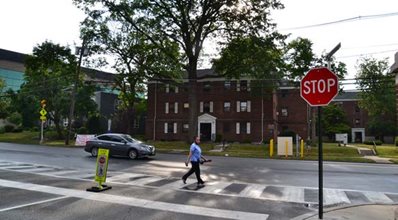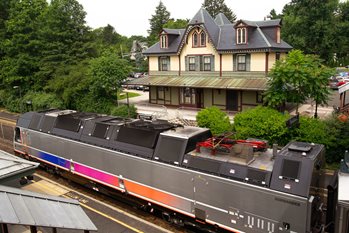April 2021
Posted: 4/27/2021 11:42:31 AM
 Imagine a cleaner and more efficient transportation future in which sustainable energy sources power vehicles that drive by themselves or fly, high-speed trains levitate, and personal mobility proliferates with high-tech options for getting around. These are just a few ideas shared by the nearly 160 children from across northern and central New Jersey who participated in the NJTPA On Air: Future of Transportation Contest.
Imagine a cleaner and more efficient transportation future in which sustainable energy sources power vehicles that drive by themselves or fly, high-speed trains levitate, and personal mobility proliferates with high-tech options for getting around. These are just a few ideas shared by the nearly 160 children from across northern and central New Jersey who participated in the NJTPA On Air: Future of Transportation Contest.
The children put on their thinking-caps and came up with innovative ideas. The contest was part of a series of outreach events aimed at gathering input for the NJTPA’s long-range plan, Plan 2050: Transportation, People, Opportunity, which is being drafted and will be adopted this fall.
Submissions were divided into four age groups, with a winner and runner-up selected in each category. You can check out a gallery of winners, semi-finalists, and other entries featured at www.NJTPA.org/OnAir.
Posted: 4/20/2021 10:25:29 AM
 The NJTPA recently concluded the second round of its Complete Streets Technical Assistance Program.
The NJTPA recently concluded the second round of its Complete Streets Technical Assistance Program.
Staff presented on the program at the joint meeting of the Planning & Economic Development and Project Prioritization committees Monday. Complete streets are streets designed for all users, all modes of transportation and all ability levels. They balance the needs of drivers, pedestrians, bicyclists, transit riders, emergency responders and goods movement based on local context.
The second phase included eight projects:
- Bergen County: Hackensack City - Walkable Community Workshop
- Essex County: West Orange Township - Walkable Community Workshop
- Middlesex County: Cranbury Township - Bicycle Corridor or Network Plan
- Middlesex County: Dunellen Borough - Walkable Community Workshop
- Monmouth County: Bradley Beach Borough - Complete Streets Conceptualizations
- Somerset County: Franklin Township - Crime Prevention Through Environmental Design Safety Audit and Site Assessment
- Somerset County: Manville Borough - Bicycle Corridor or Network Plan
- Union County: Garwood Borough - Bicycle Corridor or Network Plan
All of the final reports can be viewed on the
Complete Streets page. This phase of the program also included the creation of a brief video that explains complete streets and why communities should consider implementing them.
The NJTPA is planning to launch a third round of the competitive grant program this fall. The program provides up to $10,000 in technical assistance for four types of projects:
- Bicycle Corridor or Network Plan: Helps identifying specific routes and road treatments to improve bicycling infrastructure.
- Complete Streets Conceptual Rendering: Graphic renderings to help visualize potential improvements to streetscapes or public spaces.
- Crime Prevention through Environmental Design (CPTED) Safety Audit and Site Assessment: A workshop and street audit to assist a municipality in assessing and understanding potential physical improvements that could help prevent crime.
- Walkable Community Workshop: A workshop and audit of up to a half-mile of street to identify potential pedestrian and bicycle improvements.
Sustainable Jersey and the Alan M. Voorhees Transportation Center (VTC) at Rutgers University provide the technical assistance, which is financed through the NJTPA’s federal funding from the U.S. Department of Transportation.
Posted: 4/8/2021 10:58:37 AM
The NJTPA is committed to ensuring everyone has equal access to our planning projects and programs, regardless of ability or the language they speak. To make our website more accessible, we now offer the Recite Me tool on this website and our Street Smart NJ pedestrian safety campaign website.
Click the  accessibility button (shown to the right) at the top of the page to customize our website in the way that works best for you.
accessibility button (shown to the right) at the top of the page to customize our website in the way that works best for you.
Here's why web accessibility matters for our work:
About 9.8 percent of the people living in the NJTPA region have a disability and they can often face barriers like inaccessible websites. This prevents people from being able to access information about projects and programs that may affect them or their community.
In addition, nearly 14 percent of people in our region have limited English proficiency. The largest share of those (8 percent) speak Spanish or Spanish Creole. There are 31 different languages spoken in the NJTPA region.
For more information about our non-discrimination policies, visit our Title VI page. Our accessibility brochure, provided below in English and Spanish, offers more information on how we’re working to include everyone in the planning process:
Guide to using Recite Me
For more information on Recite Me, check out their user guide here. Here's our quick guide to using the tool on our website:
Screen Reader
The screen reader helps people who are visually impaired or neuro-divergent to perceive and understand our website. Key features include:
-
All content read aloud in a natural voice
-
35 different language options
-
Speed controls and word-by-word highlighting
-
The Recite Me toolbar allows you to highlight any text and create an MP3 file, which downloads automatically to your computer so you can listen to it offline.
Styling
Recite Me supports people who are dyslexic, visually impaired or have a learning disability, by allowing them to change the way our website looks to make it easier to interact with. The features include:
-
Adjusting text size and color and website background color
-
Changing the text font type, including Open-Dyslexic
-
A text only option, where all styling is stripped away. This leaves text only for your viewing, much like a document.
Reading
Reading content online can be a challenge for some people. To simplify and support your ability to read our content, Recite Me provides four tools:
-
Ruler: Read line by line with no distractions of what is below
-
Reading mask: Leaves only the information you want to concentrate on
-
Magnifier: Zoom in to sections of the text making reading more clearly easier
-
Margins: In text only mode you can use the margin feature to position content in the best place for you
Translation
By using Recite Me, you can quickly and easily translate all our website content into more than 100 languages, including 35 text to speech voices.
Posted: 4/7/2021 9:05:28 AM
 A team of planners from the NJTPA and American Planning Association’s New Jersey Chapter (APA-NJ) are working with the Borough of Fanwood and City of Hackensack to develop transit hub plans.
A team of planners from the NJTPA and American Planning Association’s New Jersey Chapter (APA-NJ) are working with the Borough of Fanwood and City of Hackensack to develop transit hub plans.
The municipalities were selected to participate in APA-NJ’s Community Planning Assistance Program, which provides volunteers to work on the projects. This is the second time the NJTPA is partnering with APA-NJ on this program to develop transit hub plans. The program was first piloted in 2017 and is an outgrowth of Together North Jersey, a consortium of public and private partners led by the NJTPA and Voorhees Transportation Center at Rutgers University that developed a comprehensive plan for sustainable development for North Jersey.
The Borough of Fanwood is developing a plan for the area around the rail station. The goal is to create a community-oriented, pedestrian-friendly town center that is connected to key community assets, like the Patricia M. Kuran Cultural Arts Center and the Fanwood Library. Fanwood launched a community survey in March to gather public input for the plan.
Fanwood Mayor Colleen Mahr said the planning assistance comes at a great time.
“We have experienced a great transformation of our downtown and can now further improve the area, the train station itself and better link it all to the adjoining neighborhoods and facilities,” she said.
The City of Hackensack is developing plans for a transit gateway with new public spaces, better bicycle and pedestrian access and vibrant land uses around the Essex Street train station.
The station is located near Hackensack University Medical Center, dense residential areas, the Bergen County Courthouse and government buildings, and the Main Street redevelopment district. Volunteer planners are reaching out to residents, businesses, community leaders and government officials to develop a vision for the train station and surrounding area.
“Transit hub planning is about re-thinking how to better use our streets, sidewalks, plazas and open spaces to connect important destinations with residential and business areas and make transit stations a center of the surrounding community,” Hackensack Mayor John P. Labrosse, Jr. said.
To learn about NJTPA’s previous transit hub planning work through the Community Planning Assistance Program visit APA-NJ’s website.